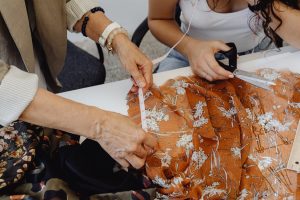The iconic Japanese kimono, a symbol of tradition and elegance, has experienced a surge in prices, reflecting broader economic trends within the country. As Japan’s economy shows signs of recovery with rising wages, increasing stock market prices, and a stronger Yen, the impact on traditional attire like kimonos and yukatas is becoming prominent.
In this blog post, we will explore the multifaceted reasons behind the escalating costs associated with these garments. From fabric and labor to shipping, each element plays a significant role in the price uptick of kimonos and yukatas.
Everyone is concerned about the rising prices of groceries, real estate, and utilities. But perhaps unexpectedly, traditional Japanese clothing, particularly kimonos, is getting pricier too. We delve into the reasons and implications behind this trend and what it might mean for aficionados of Japanese culture.
COVID-19 Impact on Japan’s Economy
The pandemic has left an indelible mark on economies worldwide, and Japan is no exception. Japan has experienced business closures and the retirement of skilled labor. Both have created a domino effect on industries, including the meticulous craft of kimono making.
The Rising Cost of Fabric and Labor
Fabric and labor have been identified as key cost drivers in the production of kimonos. The decrease in skilled labor availability and the increased demand for higher wages are contributing to the rising costs of these garments. Some industries have experienced wage hikes as high as 40%, especially those with unions.
Wages and Consumer Prices on the Rise
With wages in Japan increasing significantly, this economic adjustment is translating into higher retail prices for goods, including cultural wear like men’s yukata and women’s kimono.
The Role of Shipping Costs
Global shipping has undergone tumultuous changes, with rates soaring higher. These sharp increases in shipping costs have directly affected the pricing of kimonos imported and exported from Japan.
Future Expectations for Kimono Shopping
Looking ahead, we monitor the expected trends in kimono pricing. As economic recovery continues, we’ll share what consumers might anticipate should the Japanese Yen strengthen against the dollar.
Wrapping up, we reflect on the importance of understanding the economic conditions that shape the pricing of traditional apparel and the broader implications for Japanese culture enthusiasts and consumers worldwide.
Remember to explore our kimono shop for the latest in traditional Japanese attire, and stay informed about trends and prices. Despite rising costs, the beauty and heritage of the kimono remain timeless. We do our best to offset the rising prices by watching overhead expenses in detail. A dollar saved here means lower prices for you, our customer.
Tags: kimono online, Kimono Shop, kimono yukata, kimono yukata shop








